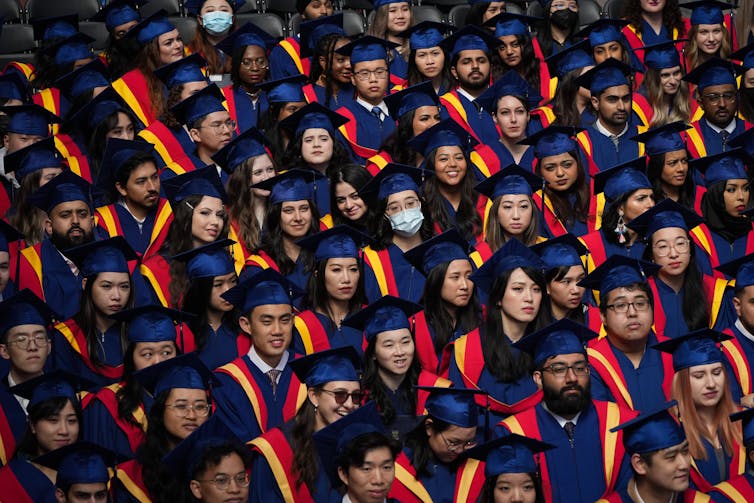Immigration, Refugees and Citizenship Canada (IRCC) has announced a new cap on international students.
In 2024, IRCC aims to issue 360,000 study permits, a 35-per-cent reduction from 2023. This announcement comes on the heels of a doubling of the cost-of-living requirement, whereby international students coming to study in any province except Québec have to demonstrate they have access to $20,635.
There is no doubt that predatory private colleges and exploitative international student recruiters have acted unethically, and steps must be taken to address their actions.
International students also deserve access to supports and services they need to thrive in Canada.
But dominant media narratives illustrated in headlines like “Canada to cap international student permits amid housing crunch” are inaccurate and harmful. They also shift responsibility away from those truly responsible: Elected officials at all levels of the government and predatory private colleges.
Baseless blame
Media coverage of the cap has also failed to consider the people at the heart of the issue — the international students themselves who, despite their significant economic ($22.3 billion) and social contributions to Canada, are being blamed for many of Canada’s biggest and long-standing challenges.
The media has also reported on the cap’s consequences for public post-secondary institutions which, for years, have commodified international students, viewing them as an important revenue source in the face of shrinking provincial government grants.
These stories have focused on how this policy will have a dire impact on the financial sustainability of universities, and how they might be forced to hike domestic/Canadian students’ tuition, which will adversely affect Canadians.
This ignores the impact on international students themselves, who have been exploited by provinces and universities for years and who are already struggling to make ends meet in Canada.
Some editorialists have argued the cap on visas and stricter work-permit rules will fix the exploitative post-secondary education “industry.”
The federal government has committed to creating a “recognized institution” framework that will see institutions set higher standards for supports, services and outcomes for international students and fast-track study permits.
Likewise, several provinces have committed to “cracking down” on predatory colleges.
But there are other ways to prevent the exploitation of international students, including supporting the transition to studying and living in Canada and creating inclusive learning environments.

Who’s responsible for the housing crisis?
The government’s official news release, along with the media coverage of the announcement, continues to scapegoat international students for some of Canada’s biggest challenges, stating that rapid increases in the number of international students arriving in Canada put “pressure on housing, health care and other services.”
This is neither accurate nor fair. It’s overly simplistic, untrue and xenophobic.
Read more: What's behind the dramatic shift in Canadian public opinion about immigration levels?
Canada’s housing availability and affordability crisis has been decades long in the making. Experts believe the housing bubble was caused by a confluence of factors including municipal, provincial/territorial and federal government policies, municipal zoning laws, developers’ interests and central bank policies.

Immigration Minister Marc Miller himself has said immigrants are key to solving the housing crisis because they bring skilled labour into the country.
By overly focusing on demand for housing — and scapegoating immigrants and international students — the government is drawing attention away from immediate actions it could take to increase supply.
The majority of international students cannot afford to compete with Canadians for homes or for rentals.
York University Prof. Tania Das Gupta’s research on Punjabi international students has found many students can only afford to spend a few hundred dollars a month on rent, forcing them to live in overcrowded and illegal basements, to share beds, to live in their cars or to face homelessness.
These students aren’t the primary driver of rising home prices or rental costs in Canada, and some economists doubt the cap will have any impact on rental prices.

Who’s responsible for health-care crisis?
International students are also being blamed for health-care challenges, despite Canada’s health-care system being significantly strained since the onset of the COVID-19 pandemic — a time when there was a massive decrease of international students coming to Canada.
Read more: The pandemic exposed the vulnerability of international students in Canada
In fact, most Canadians believe our provincial/territorial health-care systems have been in decline for more than a decade due to structural issues.
The College of Family Physicians of Canada has been sounding alarm bells for years about Canada’s need for more family physicians More than six million Canadians don’t have a family doctor.
In its recent policy proposal package, the organization states the most pressing needs for family doctors today include higher remuneration and reduced administrative burdens. International students — or immigrants, more broadly — aren’t named anywhere.
That the federal government is blaming international students for “putting pressure” on the health-care system is both a misrepresentation and an abdication of responsibility.

Replicating power, privilege
The cap, as well as the new financial requirements for international students, represent the federal government’s attempt to solve some of the pressing challenges in an ecosystem they helped create.
As Lisa Brunner, an immigration scholar at the University of British Columbia, argues, there are complex ethical issues involved in the ties that bind migration and education. International students will be shut out of Canada due to these new policies, which will ultimately replicate power and privilege.
This pattern of scapegoating in government rhetoric and in media coverage is deeply troubling. It’s already affecting public attitudes toward immigration levels, and may spill over to create negative attitudes and behaviour toward immigrants and international students themselves.
Understandably, international students are concerned and speaking out against the unfair blame being placed on them.
Read more: International students are not to blame for Canada's housing crisis
It is the responsibility of all levels of government to fix the issues they’ve helped create. This requires taking swift steps to effectively crack down on predatory colleges and unethical recruiters, and significantly increase government grants to public universities and colleges.
The government must also invest in health care and create affordable housing.
International students have not created these problems, and the government and media must stop blaming them.

